(完整版)英语语言学超强总结
英语语言学知识点总结
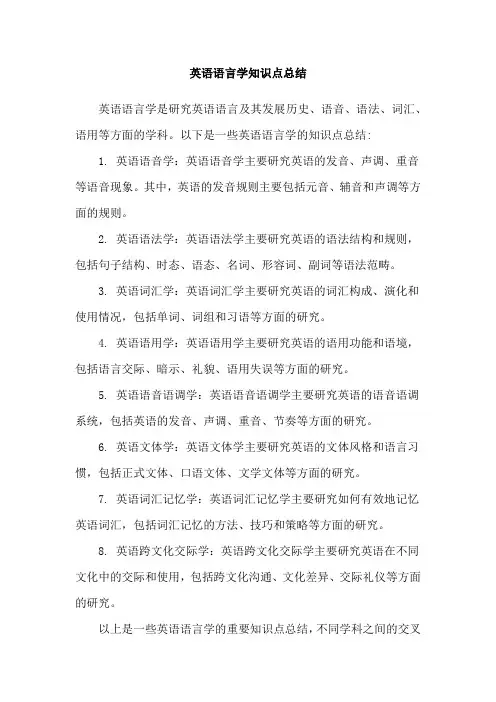
英语语言学知识点总结
英语语言学是研究英语语言及其发展历史、语音、语法、词汇、语用等方面的学科。
以下是一些英语语言学的知识点总结:
1. 英语语音学:英语语音学主要研究英语的发音、声调、重音等语音现象。
其中,英语的发音规则主要包括元音、辅音和声调等方面的规则。
2. 英语语法学:英语语法学主要研究英语的语法结构和规则,包括句子结构、时态、语态、名词、形容词、副词等语法范畴。
3. 英语词汇学:英语词汇学主要研究英语的词汇构成、演化和使用情况,包括单词、词组和习语等方面的研究。
4. 英语语用学:英语语用学主要研究英语的语用功能和语境,包括语言交际、暗示、礼貌、语用失误等方面的研究。
5. 英语语音语调学:英语语音语调学主要研究英语的语音语调系统,包括英语的发音、声调、重音、节奏等方面的研究。
6. 英语文体学:英语文体学主要研究英语的文体风格和语言习惯,包括正式文体、口语文体、文学文体等方面的研究。
7. 英语词汇记忆学:英语词汇记忆学主要研究如何有效地记忆英语词汇,包括词汇记忆的方法、技巧和策略等方面的研究。
8. 英语跨文化交际学:英语跨文化交际学主要研究英语在不同文化中的交际和使用,包括跨文化沟通、文化差异、交际礼仪等方面的研究。
以上是一些英语语言学的重要知识点总结,不同学科之间的交叉
和融合也在不断推进着英语语言学的发展。
(完整版)英语语言学超强总结
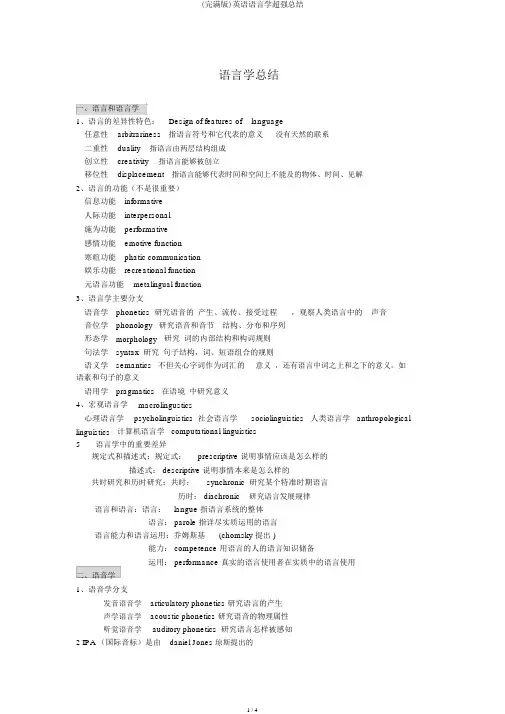
语言学总结一、语言和语言学1、语言的差异性特色:Design of features of language任意性arbitrariness指语言符号和它代表的意义没有天然的联系二重性duality指语言由两层结构组成创立性creativity指语言能够被创立移位性displacement指语言能够代表时间和空间上不能及的物体、时间、见解2、语言的功能(不是很重要)信息功能informative人际功能interpersonal施为功能performative感情功能emotive function寒暄功能phatic communication娱乐功能recreational function元语言功能metalingual function3、语言学主要分支语音学phonetics 研究语音的产生、流传、接受过程,观察人类语言中的声音音位学phonology研究语音和音节结构、分布和序列形态学morphology研究词的内部结构和构词规则句法学syntax 研究句子结构,词、短语组合的规则语义学semantics不但关心字词作为词汇的意义,还有语言中词之上和之下的意义。
如语素和句子的意义语用学pragmatics在语境中研究意义4、宏观语言学macrolingustics心理语言学psycholinguistics 社会语言学sociolinguistics 人类语言学 anthropological linguistics计算机语言学 computational linguistics5语言学中的重要差异规定式和描述式:规定式:prescriptive 说明事情应该是怎么样的描述式: descriptive 说明事情本来是怎么样的共时研究和历时研究:共时:synchronic 研究某个特准时期语言历时: diachronic研究语言发展规律语言和语言:语言:langue 指语言系统的整体语言: parole 指详尽实质运用的语言语言能力和语言运用:乔姆斯基(chomsky 提出 )能力: competence 用语言的人的语言知识储备运用: performance 真实的语言使用者在实质中的语言使用二、语音学1、语音学分支发音语音学声学语言学听觉语音学articulatory phonetics 研究语言的产生acoustic phonetics 研究语音的物理属性auditory phonetics 研究语言怎样被感知2 IPA (国际音标)是由daniel Jones 琼斯提出的三、音位学1、最小对峙体minimal pairs2、音位phoneme3音位变体allophones4互补分布 complementary distribution5自由变体 free variation6差异特色 distinctive features7超音段特色 suprasegmental feature音节syllable 重音 stress 语调 tone 声调 intonation四形态学1词的组成语素 morpheme 自由语素 free morpheme 粘着语素bound morphemeRoot 词根词缀affix词干stem屈折词汇和派生词汇inflectional affix and derivational affix2特有的词汇变化 lexical change proper新创词语 invention 混拼词 blending 缩写词 abbreviation首字母缩写词 acronym逆构词汇 back-formation 例: editor— edit类推构词 analogiacal creation 例: work-worked,,slay-slayed外来词 borrowing五句法学1范围 category 数 number性 gender 格 case 时 tense 体 aspect一致关系 concord支配关系 govenrment2结构主义学派 the structure approach组合关系syntagmatic relation 词和词组合在一起聚合关系paradigmatic 拥有共同的语法作用的词聚在一起结构和成分construction and constituents : 句子不但是线性结构liner structure 还是层级结构hierarchical structure(句子或短语被称为结构体,而组成句子或短语即结构体的称为成分) 3直接成分解析法immediate constitutional analysis指把句子分成直接成分-短语,再把这些短语依次切分,获取下一集直接成分,这样层层切分,直到不能够再分4向心结构和离心结构 endocentric and exocentric constructions向心:指一个结构中有中心词,例an old man ,中心为 man离心:指结构中没有明显的中心词。
新编简明英语语言学学习重点总结

新编简明英语语言学学习重点总结Company number:【WTUT-WT88Y-W8BBGB-BWYTT-19998】一、定义1.语言学LinguisticsLinguistics is generally defined as the scientific study of language.2.普通语言学General LinguisticsThe study of language as a whole is often called General linguistics. 3.语言languageLanguage is a system of arbitrary vocal symbols used for human communication.语言是人类用来交际的任意性的有声符号体系。
4.识别特征Design FeaturesIt refers to the defining poperties of human language that distinguish it from any animal system of communication.语言识别特征是指人类语言区别与其他任何动物的交际体系的限定性特征。
Arbitrariness任意性Productivity多产性Duality双重性Displacement移位性Cultural transmission文化传递⑴arbitrarinessThere is no logical connection between meanings and sounds.the arbitrary nature of language is a sign of sophistication and it makes it possible for language to have an unlimited source of expressions⑵ProductivityAnimals are quite limited in the messages they are able to send.⑶DualityLanguage is a system, which consists of two sets of structures ,or two levels.⑷DisplacementLanguage can be used to refer to contexts removed from the immediate situations of the speaker.⑸Cultural transmissionHuman capacity for language has a genetic basis, but we have to be taught and learned the details of any language system. this showed that language is culturally transmitted. not by instinct. animals are born with the capacity to produce the set of calls peculiar to their species.5.语言能力CompetenceCompetence is the ideal user’s knowledge of the rules of his language.6.语言运用performancePerformance is the actual realization of this knowledge in linguistic communication.语言运用是所掌握的规则在语言交际中的体现。
英语语言学复习总结
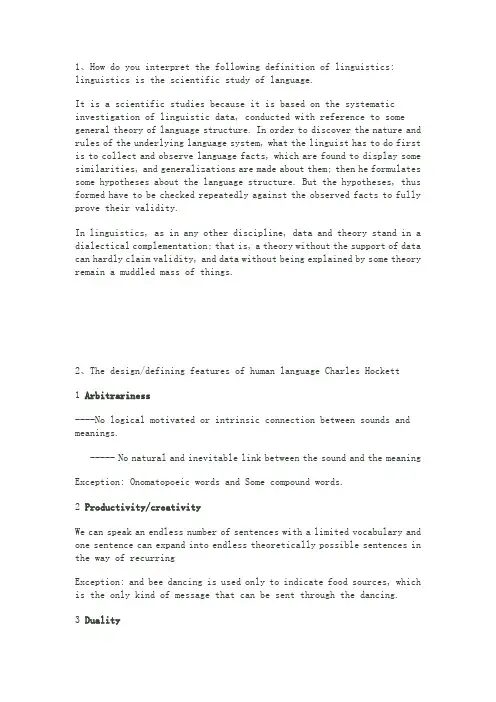
1、How do you interpret the following definition of linguistics: linguistics is the scientific study of language.It is a scientific studies because it is based on the systematic investigation of linguistic data, conducted with reference to some general theory of language structure. In order to discover the nature and rules of the underlying language system, what the linguist has to do first is to collect and observe language facts, which are found to display some similarities, and generalizations are made about them; then he formulates some hypotheses about the language structure. But the hypotheses, thus formed have to be checked repeatedly against the observed facts to fully prove their validity.In linguistics, as in any other discipline, data and theory stand in a dialectical complementation; that is, a theory without the support of data can hardly claim validity, and data without being explained by some theory remain a muddled mass of things.2、The design/defining features of human language Charles Hockett1 Arbitrariness----No logical motivated or intrinsic connection between sounds and meanings.----- No natural and inevitable link between the sound and the meaning Exception: Onomatopoeic words and Some compound words.2 Productivity/creativityWe can speak an endless number of sentences with a limited vocabulary and one sentence can expand into endless theoretically possible sentences in the way of recurringException: and bee dancing is used only to indicate food sources, which is the only kind of message that can be sent through the dancing.3 Duality▪Lower level----sounds meaningless▪Higher level----meaning larger units of meaningException: the grouping of the three sounds/k/,/a:/,and/p/ can mean either a kind of fishcrap, or a public place for rest and amusementpark.4 DisplacementDisplacement means that human languages enable their users to symbolize objects, events and concepts which are not present in time and space at the moment of communication.Exception: Yesterday which book did you read5 Cultural transmissionLanguage can transmit Culture which the language contains.Exception;an English speaker and a Chinese speaker are both able to use a language, but they are not mutually intelligible. This shows that language is culturally transmitted.3、word formation1CompoundIt refers to those words that consist of more than one lexical morpheme, or the way to join two separate words to produce a single form. icecream, sunrise, paperbag2 DerivationIt refers to the formation of new words by adding affixes to other words or morphemes.Unconscious, national, nationalize3 BlendingIt refers to the form of compounding, in which two words are blended by joining the initial part of the first word and the final part of the second word, or by joining the initial parts of the two words.Smoke + fog = smog 烟雾4 Abbreviation1cutting the final part or with a slightvariation advertisement-----ad2 cutting the initial part aeroplane -----plane3 cutting both the initial and final parts accordingly refrigerator ---- fridge5 AcronymIIt is made up from the first letters of the name of an organization, which has a heavily modified headword. WB : World BankAcronymIIThis process is also widely used in shortening extremely long words of word groups in science, technology and other special fields. VAT : value added tax 增殖税6 Back- formationIt refers to an abnormal type of word-formation where a shorter word is derived by deleting an imagined affix from a longer form already in the languageEditor ------edit7 BorrowingLatin: cancer, page, .that is . for example etc. et ceteraChinese: taji, chow mein, kung-fuJapanese: JudoFrench, German, Italian, Spanish8 InventionSince economic activities are the most important and dynamic in human life, many new lexical items come directly from the consumer items, their producers or their brand names such as Kodak, Coke, nylon, and others to cope with the Invention of new entities.4. XP rulerule: specifier + head + complement2. XP rule: SpecifierX’X’à Xcomplement3. XP rule :Specifier X Complement4. XP rule:Spec Mod X Complement ModComplement: in grammar that part of the sentence which follows the verb and which thus completes the sentence.Features:Ø one or more complements are permittedØ eg. A story about a sentimental girl with purple umbrella …Ø words that can take CP are not verbs alone. As, Ns and Ps can all take CPØ. take it; poor as a chuch mouse;the man with hat;right near the fireplaceØ A certain lexical item requires a certain type of complement.Ø. come to school; go to bed; look through itModifier: is used to specify optionally expressible properties of heads.Modifier position in EnglishModifier Position exampleAP Precedes the head a very careful girlPP Follows the head open with careAdvP Precedes or follows thehead read carefully; carefully read5. 请从Behaviorism 的角度来举例说明其意义:Behaviorists attempted to define the meaning of a language form as the “situation in which the speaker utters it and the response it calls forth in the hearer.”S__Tang Wanyi_____r--------s______Vicky______RWhen Tang Wanyi sees an apple and wants to have it, she has a physical stimulus, represented by the capital letters, which gives rise to a verbal responser to Vicky. For instance, she might say to Vicky ”I’m thirsty”. What she says results in a verbal stimulus to Vicky represented by the small letter S. This stimulus, in its turn, leads to a non-verbal response from Vicky, such as picking the apple for her.6. synonymy同义现象Synonymy refers to the sameness or close similarity of meaning. Words that are close in meaning are called synonyms1 Dialectal synonyms---- synonyms used in different regional dialects 地区方言autumn - fall, biscuit - cracker, petrol – gasoline 地方2 Stylistic synonyms----synonyms differing in style,文体风格上不同kid, child, offspring; start, begin, commence;3 Synonyms that differ in their emotive or evaluative meaningexamples in Mandarin情感上和评价判断上的不同合作者/同谋;结果/下场;鼓励/…;领袖/…;赞扬/…团结4 Collocational synonyms搭配意义上的不同A group of people; a herd of wolves; a swarm of bees5 Semantically different synonyms语义不同surprise/astonish; finish/complete7、locutionary act, illocutionary act,perlocutionary actFor example,“It is cold in here.”Its locutionary act is the saying of it with its literal meaning “the weather is clod in here” ;Its illocutionary act can be a request of the hearer “to shut the window” ;Its perlocutionary act is the effect brought about; it can be “the hearer’s shutting the window or his refusal to comply with the request”.作业本You have left the door wide open① the locutionary act performed by the speaker is his utterance of all the words ”you”, ”have”, ”door”, ”open”, etc. thus expressing what the words literally mean② the illocutionary act performed by the speaker is that by making such an utterance he has expressed his intention of speaking. . asking someone to close the door.③ The perlocutionary act refers to the effect result of the utterance. It can be “the hearer clos e the door or refuse to comply with the request.8、Four maxims of CP IThe maxim of quality----Do not say what you believe to be false.----Do not say that for which you lack adequate evidence.The maxim of quantity----Make your contribution as informative as required for the current purpose of the exchange.----Do not make your contribution more informative than is required. The maxim of relation----Be relevant make your contribution relevant.The maxim of manner----Avoid obscurity of expression.----Avoid ambiguity.----Be brief.----Be orderly.先判断在分析,先判断是不是relation从literal meaning是不是同一个主题Conversational implicature会话含义,言外之意;会话含意In real communication, however, speakers do not always observe these maxims strictly. These maxims can be violated for various reasons. When any of the maxims is violated, . both the speaker and the hearer are aware of the violation, our language becomes indirect, then conversational implicature arises.填空,definition 判断选择Phonetics: the study of sounds used in linguistic communication led to establishment of phoneticsPhonology: how sounds are put together and used to convey meaning in communication.Morphology: is concerned with the internal organization of words. It studies the minimal units of meaning morphemes and word-formation processesSyntax: the study of how word combine to form sentences and the rules which govern the formation of sentences.Semantics: it examines how meaning is encoded in language. It is concerned with 1meanings of the words. 2 levels of language below the word and above itPragmatics: the study of the use of language in communication, particularly the relationships between sentences and the contexts and situation in which they are used.Sociolinguistics: the study of all these social aspects of language and its relation with society form the core of the branchPsycholinguistics: relates the study of language to psychology. It aims to answer such questions as how the human mind works when we use language, how…. , how…Articulatory phonetics发音语音学----from the speakers’ point of view, “how speakers produce speech sounds”--------speakingAcoustic phonetics声学语音学;----from the physical way or means by which sounds are transmitted from one to another.-------soundingAuditory phonetics听觉语音学----from the hearers’ point of view, “how sounds are perceived”--------listeningClassification of consonants---- English consonants may be classified according to two dimensions: ▪The manner of articulation▪The place of articulationBroad transcription ---- used in dictionary and textbook for general purpose, without diacritics, . clear l , pitNarrow transcription ---- used by phonetician for careful study, with diacritics, . dark l , aspirated pSemantics----the study of language meaning.Meaning is central to the study of communication.Naming theory’s Limitations1 Applicable to nouns only.2 There are nouns which denote things that do not exist in the real world.3 There are nouns that do not refer to physical objects but abstract notions.Conclusion on semantic triangleThe symbol or form refers to the linguistic elements words and phrases; The referent refers to the object in the world of experience; Thought or reference refers to concept.Relations:The symbol or a word signifies things by virtue of the concept associated with the form of the word in the minds of the speaker; and the concept looked at from this point of view is the meaning of the word.7. Antonymy反义现象Antonymy: refers to the oppositeness of meaning.1. Gradable antonyms----there are often intermediate forms between the two members of a pair. Old-young, hot-cold, tall-short2. Complementary antonyms----the denial of one member of the pair implies the assertion of the other. Alive-dead, male-female, …3. Relational opposites----exhibits the reversal of the relationship between the two itemsHusband-wife, father-son, doctor-patient, buy-sell, employer-employee, give-receive…8. Homonymy同形异义Homonymy---- the phenomenon that words having different meanings have the same form, . different words are identical in sound or spelling, or in both.Homophone ---- when two words are identical in sound, rain-reign, night/knight, …Homogragh ---- when two words are identical in spelling. tearn.-tearv., leadn.-leadv., …Complete homonym---- when two words are identical in both sound and spelling, ballE,F, bank, watch, scale, fast, …Polysemy----the same one word may have more than one meaning.▪“table” may mean:▪1. A piece of furniture▪2. All the people seated at a table▪ food that is put on a table▪4. A thin flat piece of stone, metal wood, etc.▪5. Orderly arrangement of facts, figures, etc.……X entails Y蕴含关系▪X: John married a blond heiress.▪Y: John married a blond.▪X: Marry has been to Beijing.▪Y: Marry has been to China.▪Entailment is a relation of inclusion. If X entails Y, then the meaning of X is included in Y.▪If X is true, Y is necessarily true; if X is false, Y may be true or false.X presupposes Y预射关系▪X: His bike needs repairing.▪Y: He has a bike.▪Paul has given up smoking.▪Paul once smoked.▪If X is true, Y must be true; If X is false, Y is still true.The Relatedness between Language and SocietyThere are many indications of the inter-relationship between language and society.1. Language is often used to establish and maintain social relationships2. The use of language is in part determined by the user’s social background. social class, age, sex, education level, etc.3. Language, especially the structure of its lexicon, reflects both the physical and the social environments of a society. “snow” for Eskimo4. As a social phenomenon language is closely related to the structure of the society in which it is used, the evaluation of a linguistic form is entirely social the postvocalic r .Predication analysisIII1 The meaning of a sentence is not to be worked out by adding up all the meanings of its component words, “The dog bites the man” is semantically different from “The man bites the dog” though their components are exactly the same.2 There are two aspects to sentence meaning: grammatical meaning and semantic meaning, .Green clouds are sleeping furiously.Sincerity shook hands with the black apple.Whether a sentence is semantically meaningful is governed by rules called selectional restrictions.According to the number of arguments contained in a predication, we may classify the predications into the following types:One-place predication: smoke, grow, rise, run, …Two-place predication: like, love, sa ve, bite, beat,…Three-place predication: give, sent, promise, call, …No-place predication: It is hot.I like youtwo placeIt is hot no place…Performatives’Features Austin’s“I declare the meeting open.”1. first person, singular subject2. simple present tense3. indicative mood4. active voice5. performative verbs基本上所有的动词都是perfomativesSearle’s Classification of Speech Acts 1969判断出是那一种Assertives/representatives陈述---- Stating or describing, saying what the speaker believes to be true, .I think the film is moving.I’m certain I have never seen the man before.I solemnly swear that he had got it.…I think it is good.Directives指令---- Trying to get the hearer to do something, .I order you to leave right now.Open the window, please.Your money or your life…Sit down, please.Commissives承诺---- Committing the speaker himself to some future course of action, such as promise or a threat. .I will bring you the book tomorrow without fail.If you do not stop fighting, I’ll call the polic e.I promise to come.Expressives表达----Expressing the speaker’s psychological statefeeling and attitudes about something,such as an aplology, a complaint, to thank someone, to congratulate someone. .I’m sorry for being late.I apologize for the sufferings that the war has caused to your people.…You are so wonderfulDeclarations宣告----Bringing about an immediate change in the existing state or affairs, now appoint you chairman of the committee.You are fired.I now declare the meeting open.…I now pronounce you man and wife.Note: All the acts that belong to the same category share the same purpose but differ in their strength or force, .1I guess / am sure / swear he is the murderer..2In order to get someone open the door, we can choose one from a variety of the forms in below:Could you open the door, pleaseCan you open the doorDo you mind opening the doorOpen the doorThe door pleaseLanguage changeperiods1 449—1100: Old EnglishBeginning: English-speaking Anglo-Saxon and Jutes invaded into the British IslesThe End: “Norman Conquest” : the arrival of Norman French invadersGlæs; guma; gat----glass ---man ---goat“Beowulf”---England 8century poem,brave warrior2 1100—1500 Middle EnglishBeginning: “Norman Conquest” : the arrival of Norman French invadersThe End:“European Renaissance Movement”Latin and French“The Canterbury Tales”----Geoffrey Chaucer 1345-14003 1500—the present Modern EnglishBeginning: “European Renaissance Movement”The End: the presentDiphthongs appears: ai, au, ei, eu, ou, oiBecause of pressing industry overspreading, the spelling forms are determined/less changes.Regional dialectReason: This differentiation is accounted for the lack of communication in the old days when travel was difficult.Female Speech’s Features1. Women are usually more status-conscious than men in theEnglish-speaking world; therefore, their speech closely approaches the standard variety than the speech of men.2. The female speakers tend to have a wider range in their intonation.3. Female speech is, on the whole, less assertive and thus sounds to be more polite than male speech.Register: a Speech Variety used by a particular group of people, usually sharing the same occupation . doctors, lawyers or the same interests . stamp collectors, baseball fans.In a broader sense, according to Halliday, “language varies as its function varies; it differs in different situations.” The type of language which is selected as appropriate to the type of situation is a register.Halliday further distinguishes three social variables that determine the register:▪field of discourse,▪tenor of discourse,▪mode of discourseField of discourse: what is going on: to the area of operation of the language activity. It is concerned with the purpose why and subject matter about what of communication. It can be either technical or non-technical.Tenor of discourse:the role of relationship in the situation in question: who are the participants in the communication and in what relationship they stand to each other. customer-shop-assistant, teacher-student, etc.Mode of discourse:the means of communication. It is concerned with how communication is carried out. oral, written, on the line…Standard Variety:=standard dialect=standard language:the variety of a language which has the highest Status in a community of nation and which is usually based on the speech and writing of educated native speakers of the language.The standard variety is a superimposed, socially prestigious dialect of a language. It is the language employed by the government and the judiciary system, used by the mass media, and taught in educational institutions, including school settings where the language is taught as a foreign or second language.Edward Sapir and Benjamin Whorf, proclaimed that the structure of the language people habitually use influences the ways they think and behave, . different languages offer people different ways of expressing the world around, they think and speak differently, this is also known as linguistic relativity.Sapir and Whorf believe that language filters people’s perception and the way they categorize experiences. This interdependence of language and thought is now known as Sapir-Whorf Hypothesis.文化影响语言,语言影响文化The inadequacy of behaviorist view1. What they imitate must be based on what the children have already known instead of what is “available” in the environment.2. They imitate words selectively and according to their own understandings of the sounds or patterns.3. how children acquire complex language system.Language acquisition device: LAD the capacity to acquire one’s First language, when this capacity is pictured as a sort of mechanism or apparatus.Universal Grammar: a theory which claims to account for the grammatical competence of every adult no matter what language he or she speaks. 了解一下UGprototype原型It claims that every speaker knows a set of principles which apply to all languages and also a set of Parameters that can vary from one language to another, but only within certain limits.According to UG theory, acquiring a language means applying the principles of UG grammar to a particular language, . English, French or German, and learning which value is appropriate for each parameter.Motherese’s Features1. shorter utterances than speech to other adults2. grammatically simple utterances3. few abstract or difficult words, with a lot of repetition4. clearer pronunciation, sometimes with exaggerated Intonation patterns CommentBehaviorists view sounds reasonable in explaining the routine aspects;The innatist accounts most plausible in explaining children’s acquiring complex system;And the interactionist description convincing in understanding how children learn and use the language appropriately from their environment.Critical Period Hypothesis CPH---- Eric Lenneberg argues that the LAD, like other biological functions, works successfully only when it is stimulated at the right time ---- a specific and limited time period for language acquisition.The strong version of CPH suggests that children must acquire their first language by puberty or they will never be able to learn from subsequent exposure.The weak version holds that language learning will be more difficult and incomplete after puberty. Support in Victor’s and Genie’s casesVocabulary development1 Under-extension 外延缩小2 Over-extension外延延伸3 Prototype theoryGrammatical development1 Telegraphic speech 22 Sentences of three main elementsContrastive analysis CAthe comparison of the linguistic systems of two languages, for example the sound system or the grammatical system. Contrastive analysis was developed and practiced in the 1950s and 1960s, as an application of Structural Linguistics to language teaching, and is based on the following assumptions1. The main difficulties in learning a new language are caused by interference from the first language. language transfer2. These difficulties can be predicted by contrastive analysis.materials can make use of contrastive analysis to reduce the effects of interference1970s, it declined and was replaced by Error Analysis▪Language transfer:the effect of one language on the learning of another. Two types of language transfer may occur.▪“I am here since Monday.”▪“ I have been here since Monday.”▪Because of the transfer of the French pattern▪Je suis ici depuis lundi▪Negative transfer,负向转移 also known as interference, is the use of a native language pattern or rule which leads to an Error orinappropriate form in the Target Language. For example, a Frenchlearner of English may produce the incorrect sentence ▪“table, transport,restaurant, surprise”▪Positive transfer,正向转移 is transfer which makes learning easier, and may occur when both the native language and the target languagehave the same form. For example, both French and English have theword ‘table’, which can have the same meaning in both languages.Interlingual errorsInterlingual errors mainly result from cross-linguistic interference at different levels such as phonological, lexical, grammatical or discoursal etc. For examples,a. Substitution of t for W and d for T: threeàtree, thisàdis.b. Shortening of long vowels: sheepàship, meetàmitIntralingual errorsThe intralingual errors mainly from faulty or partial learning of the target language, independent of the native language.▪Two types of errors have been well exploited:overgeneralization & cross-associationTrue or False1. In an exciting argument, the speakers could express themselves fluently2. In an exciting argument, the speakers have grammatical expressions all the time3. After your listening others’ speech, could you repeat it totally4. About pre-school children who can not read but can speak, do you think they can identify the noun and verb in speaking “an apple” is a thing; “run” is an action5. And also about pre-school children who can not read but can speak, do you think they can define the term “noun”三、pairPrescriptive vs DescriptiveHe love that picture. We see a film yesterday.Prescriptive ----lay down rules for “correct” linguistic behavior in using languagetradition grammar“Give me that cup.” “ Could you bring me that cup”“ Cup”Descriptive ---- describe/analyze linguistic facts observed or language people actually use modern linguisticsSynchronic vs diachronicA Grammar of Modern GreekThe Structure of Shakespear’s EnglishSynchronic study---- description of a language at some point of timeLangue vs parole F. de SaussureLangue ---- the abstract linguistic system shared by all members of the speech community.Parole ---- the realization of langue in actual use.Saussure takes a sociological view of language and his notion of langue is a matter of social conventions.Langue is the lexical, grammatical, and phonological constitution of a language to be implanted in the native speaker’s mind or brain in childhood as the collective product of the speech community envisaged as a supra-individual entity in its own right. In speaking his language thespeaker could only operate or perform within this langue; what he actually uttered was parole, and the only individual control he could exercise was when to speak and about what to speak.The aim to distinguish them is to abstract langue from parole. The reason to distinguish them is that parole is simply a mass oflinguistic facts, too varied and confusing for systematic investigation.Langue Parole 1.abstract concrete 2all the members in actual use 3 linguistic competence of the speaker actual phenomena or data oflinguistics utterance4 not accessible5 social individual6 essential accidentalconclusion S ocial bond constitutes languageActive use of speakingCompetence and performance ChomskyCompetence ---- the i deal user’s knowledge of the rules of his language Performance ---- the actual realization of this knowledge in linguistic communicationChomsky looks at language from a psychological point of view and to him competence is a property of the mind of each individual.distribution2. Phonemic contrast;pair.Complementary distribution----allophones of the same phoneme are in complementary distribution. They do not distinguish meaning. They occur in different phonetic contexts. They never occur in the same context.Phonemic contrast----similar sounds, meanwhile can be used to distinguish the two phonemes, they are said to form a phonemic contrast.Minimal pair----two words in a language which differ from each other by only one distinctive sound one Phoneme and which also differ in meaning.Derivational morpheme & inflectional morphemekindness; international; friendlyroot & affix----- Derivational morphemesfriendlytalks; talking; talked; boy’s; applesstem & affix----- Inflectional morphemesfriendsLexical meaning---basic notion of meaningsense: a dog: a domestic canine mammal, occurring in many breeds that show a great variety in size and form.Reference: the dog. a particular dog, we all know which one it is.vs. SemanticsPragmatics Semantics 1Study of the language in use The study of meaning 2Concerning the context Intrinsic, inherent 3More indeterminate, sth extra More constant 4Related to the context Inherent side of meaning 5Pragmatics = meaning – semanticsContext---- occurs before and/or after a word, a phrase or even a longer utterance or a text. The context often helps in understanding the particular meaning of the word, phrase, etcTypes:1. context of situation: Do you prepare enoughof culture: Jane Eyremeaning vs. utterance meaningSentence meaning utterance meaning1 Abstract and context-independent meaning concrete and context-dependentmeaning2 literal meaning of a sentence i ntended meaning of a speaker3 What does X mean What did you mean by X。
新编简明英语语言学学习重点总结
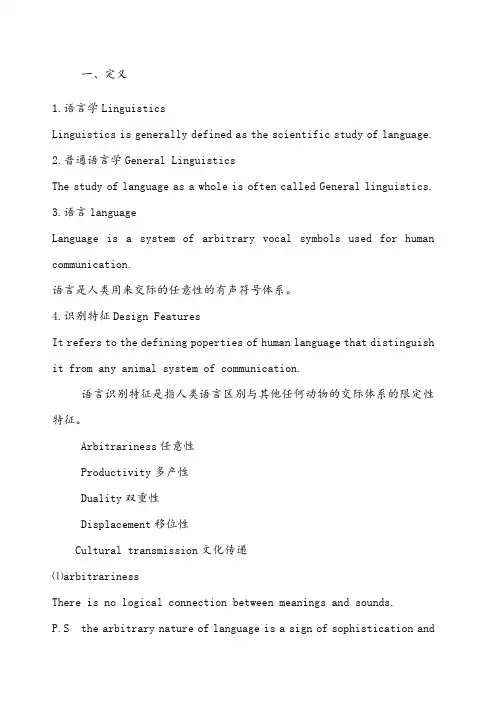
一、定义1.语言学LinguisticsLinguistics is generally defined as the scientific study of language.2.普通语言学General LinguisticsThe study of language as a whole is often called General linguistics.3.语言languageLanguage is a system of arbitrary vocal symbols used for human communication.语言是人类用来交际的任意性的有声符号体系。
4.识别特征Design FeaturesIt refers to the defining poperties of human language that distinguish it from any animal system of communication.语言识别特征是指人类语言区别与其他任何动物的交际体系的限定性特征。
Arbitrariness任意性Productivity多产性Duality双重性Displacement移位性Cultural transmission文化传递⑴arbitrarinessThere is no logical connection between meanings and sounds.P.S the arbitrary nature of language is a sign of sophistication andit makes it possible for language to have an unlimited source of expressions⑵ProductivityAnimals are quite limited in the messages they are able to send.⑶DualityLanguage is a system, which consists of two sets of structures ,or two levels.⑷DisplacementLanguage can be used to refer to contexts removed from the immediate situations of the speaker.⑸Cultural transmissionHuman capacity for language has a genetic basis, but we have to be taught and learned the details of any language system. this showed that language is culturally transmitted. not by instinct. animals are born with the capacity to produce the set of calls peculiar to their species.5.语言能力CompetenceCompetence is the ideal user’s knowledge of the rules of his language.6.语言运用performancePerformance is the actual realization of this knowledge in linguistic communication.语言运用是所掌握的规则在语言交际中的体现。
英语语言学 总结
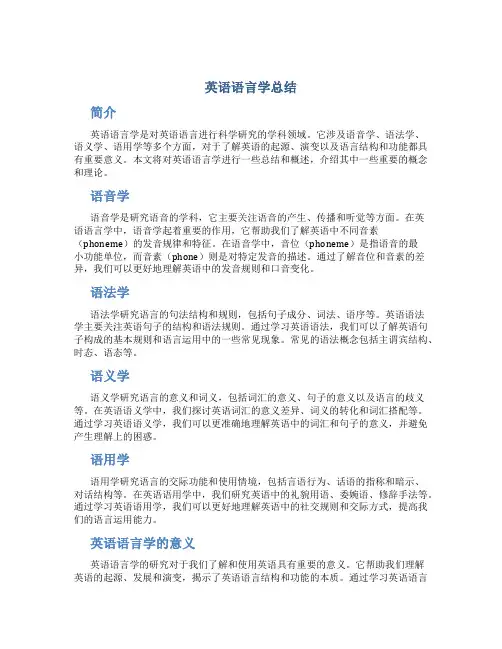
英语语言学总结简介英语语言学是对英语语言进行科学研究的学科领域。
它涉及语音学、语法学、语义学、语用学等多个方面,对于了解英语的起源、演变以及语言结构和功能都具有重要意义。
本文将对英语语言学进行一些总结和概述,介绍其中一些重要的概念和理论。
语音学语音学是研究语音的学科,它主要关注语音的产生、传播和听觉等方面。
在英语语言学中,语音学起着重要的作用,它帮助我们了解英语中不同音素(phoneme)的发音规律和特征。
在语音学中,音位(phoneme)是指语音的最小功能单位,而音素(phone)则是对特定发音的描述。
通过了解音位和音素的差异,我们可以更好地理解英语中的发音规则和口音变化。
语法学语法学研究语言的句法结构和规则,包括句子成分、词法、语序等。
英语语法学主要关注英语句子的结构和语法规则。
通过学习英语语法,我们可以了解英语句子构成的基本规则和语言运用中的一些常见现象。
常见的语法概念包括主谓宾结构、时态、语态等。
语义学语义学研究语言的意义和词义,包括词汇的意义、句子的意义以及语言的歧义等。
在英语语义学中,我们探讨英语词汇的意义差异、词义的转化和词汇搭配等。
通过学习英语语义学,我们可以更准确地理解英语中的词汇和句子的意义,并避免产生理解上的困惑。
语用学语用学研究语言的交际功能和使用情境,包括言语行为、话语的指称和暗示、对话结构等。
在英语语用学中,我们研究英语中的礼貌用语、委婉语、修辞手法等。
通过学习英语语用学,我们可以更好地理解英语中的社交规则和交际方式,提高我们的语言运用能力。
英语语言学的意义英语语言学的研究对于我们了解和使用英语具有重要的意义。
它帮助我们理解英语的起源、发展和演变,揭示了英语语言结构和功能的本质。
通过学习英语语言学,我们可以更好地掌握英语的发音、词汇、语法和语用等方面的知识,提高我们的英语语言能力。
此外,英语语言学还对翻译、教学、翻译和语言政策等领域有着重要的影响。
结论通过对英语语言学的总结,我们对英语语言的研究有了更深刻的认识。
(最新版)新编英语语言学复习知识点整理
第一单元What is linguistics? 什么是语言学?Linguistics is generally defined as the scientific study of language. It studies not any particular language, but languages in general.The scope of linguistics 语言学研究的范畴Phonetics语音学\Phonology音系学\Morphology 形态学\Syntax句法学\Semantics语义学\Pragmatics语用学\Sociolinguistics社会语言学\Psycholinguistics心理语言学\Applied linguistics 应用语言学Phonetics语音学:the study of sounds used in linguistic communication led to the establishment of a branch of linguistics called phonetics Phonology音系学:as linguists became interested in how sounds put together and used to convey meaning in communication ,they developed another branch of study related to sounds called phonology.Morphology形态学:the study of the way in which these symbols are arranged form words has constituted the branch of study called morphology.Syntax句法学:the combination of these words to form permissible sentences in languages is governed by rules ,the study of these rules constitutes a major branch of linguistics studies Semantics语义学:the study of meaning was gradually developed and became known as semanticsPragmatics语用学:when the study of meaning is conducted,not in isolaion,but in the context of use,it becomes another branch of linguistic study called pragmaticsSociolinguistics社会语言学:the study of all these social aspects of language and its relation with society form the core of the branch called sociolinguisticsPsycholinguistics心理语言学: Psycholinguistics relates the study of language to psychology\Applied linguistics应用语言学:findings in linguistic studies can often be applied to the solution of such practical problems as the recovery of speech ability.the study of such applications is generally known as applied linguisticsOther related branchs include anthropological linguistics,neurological linguistics,mathematical linguistics,and computational linguistics.Some important distinctions in linguistics。
语言学知识点+整理
第一单元What is linguistics? 什么是语言学?Linguistics is generally defined as the scientific study of language. It studies not any particular language, but languages in general.The scope of linguistics 语言学研究的范畴Phonetics语音学\Phonology音系学\Morphology形态学\Syntax句法学\Semantics语义学\Pragmatics语用学\Sociolinguistics社会语言学\Psycholinguistics心理语言学\Applied linguistics应用语言学Phonetics语音学:the study of sounds used in linguistic communication led to the establishment of a branch of linguistics called phoneticsPhonology音系学:as linguists became interested in how sounds put together and used to convey meaning in communication ,they developed another branch of study related to sounds called phonology.Morphology形态学:the study of the way in which these symbols are arranged form words has constituted the branch of study called morphology.Syntax句法学:the combination of these words to form permissible sentences in languages is governed by rules ,the study of these rules constitutes a major branch of linguistics studies Semantics语义学:the study of meaning was gradually developed and became known as semanticsPragmatics语用学:when the study of meaning is conducted,not in isolaion,but in the context of use,it becomes another branch of linguistic study called pragmaticsSociolinguistics社会语言学:the study of all these social aspects of language and its relation with society form the core of the branch called sociolinguisticsPsycholinguistics心理语言学: Psycholinguistics relates the study of language to psychology\Applied linguistics应用语言学:findings in linguistic studies can often be applied to the solution of such practical problems as the recovery of speech ability.the study of such applications is generally known as applied linguisticsOther related branchs include anthropological linguistics,neurological linguistics,mathematical linguistics,and computational linguistics.Some important distinctions in linguistics。
英语语言学总结
第一章All languages have three major components: a sound system, a system of lexicogrammar and a systm of semantics. 语音系统,词汇语法系统和语义系统。
Language is a means of verbal communication.Design Features of language: the features that define our human languages. 决定了语言性质特征叫定义特征Design Features:Arbitratiness(任意性):the froms of liguistic signs bear no natural relationsip to their meaning.语言符号的形式与所表示的意义没有天然的联系。
1\ Arbitrary relationship between the sound of a morpheme and ists meaning语素音义关系的任意性2\ Arbitrariness at the syntactic level 句法层面上的任意性。
Syntactic: the sentences are constructed according tothe grammar of arrangement. 句法学,是依据语法规定构建句子结构的方法。
3\ Arbitrariness and convention 任意性和规约性Duality(二层性):is meant the propertry of having two levels of structures, such that units of the primary level are composed ofelements of the secondary level and each of the two levelshas its own principles of organization. 二层性是指拥有两层结构的这种特性,上层结构的单位底层结构的元素构成,每层都有自身的组合规则。
语言学概论知识汇总(英文)
第一章Invitation to Linguistics1.Definition of language:Language is a system of vocal (and written) symbols with meaning attached that is used forhuman communication of thoughts and feelings.2.Design features of language(语言的普遍特征):①.Arbitrariness 任意性:The forms of linguistic signs generally bear no natural relationship to the meanings they carry②.Duality 二重性:Human language has two levels of structures: the primary meaningful level of morphemes, words, phrases, sentences and the secondary meaningless level of sounds. The units of the primary level are composed of elements of the secondary level, and each of the two levels has its own principles of organization.③.Creativity 创造性:Language is resourceful because of its duality and recursiveness.④.Displacement移位性:Human languages enable their users to symbolize objects, events and concepts which are not present in time and space at the moment of communication.3.Functions of language1)Informative function2)Interpersonal function人际功能3)Performative (行为) function4)Emotive function5)Phatic (寒暄) function6)Recreational function7)Metalingual function(元语言功能)指用语言去说明或解释语言的功能4.Main branches of linguistics:Main branches of linguistics (microlinguistics微观) and interdisciplinary(跨领域、跨学科)fields of linguistics (macrolinguistics宏观)1) Main branches of linguistics:(1) Phonetics发音学,语音学;(2) Phonology;(音位学、语音体系)(3) Morphology 词法/ Lexicology词汇学;(4) Syntax句法;(5) Semantics语义学(6) Pragmatics语用学:研究特定情境中的特定话语,在不同的语言交际环境中如何理解和运用语言支。
- 1、下载文档前请自行甄别文档内容的完整性,平台不提供额外的编辑、内容补充、找答案等附加服务。
- 2、"仅部分预览"的文档,不可在线预览部分如存在完整性等问题,可反馈申请退款(可完整预览的文档不适用该条件!)。
- 3、如文档侵犯您的权益,请联系客服反馈,我们会尽快为您处理(人工客服工作时间:9:00-18:30)。
语言学总结一、语言和语言学1、语言的区别性特征:Design of features of language任意性arbitrariness 指语言符号和它代表的意义没有天然的联系二重性duality 指语言由两层结构组成创造性creativity 指语言可以被创造移位性displacement 指语言可以代表时间和空间上不可及的物体、时间、观点2、语言的功能(不是很重要)信息功能informative人际功能interpersonal施为功能performative感情功能emotive function寒暄功能phatic communication娱乐功能recreational function元语言功能metalingual function3、语言学主要分支语音学phonetics 研究语音的产生、传播、接受过程,考查人类语言中的声音音位学phonology 研究语音和音节结构、分布和序列形态学morphology 研究词的内部结构和构词规则句法学syntax 研究句子结构,词、短语组合的规则语义学semantics 不仅关心字词作为词汇的意义,还有语言中词之上和之下的意义。
如语素和句子的意义语用学pragmatics 在语境中研究意义4、宏观语言学macrolingustics心理语言学psycholinguistics 社会语言学sociolinguistics 人类语言学anthropological linguistics 计算机语言学computational linguistics5语言学中的重要区别规定式和描写式:规定式:prescriptive说明事情应该是怎么样的描写式:descriptive 说明事情本来是怎么样的共时研究和历时研究:共时:synchronic 研究某个特定时期语言历时:diachronic 研究语言发展规律语言和言语:语言:langue指语言系统的整体言语:parole指具体实际运用的语言语言能力和语言运用:乔姆斯基(chomsky提出)能力:competence用语言的人的语言知识储备运用:performance 真实的语言使用者在实际中的语言使用二、语音学1、语音学分支发音语音学articulatory phonetics研究语言的产生声学语言学acoustic phonetics 研究语音的物理属性听觉语音学auditory phonetics 研究语言怎样被感知2 IPA(国际音标)是由daniel Jones琼斯提出的三、音位学1、最小对立体minimal pairs2、音位phoneme3 音位变体allophones4 互补分布complementary distribution5 自由变体free variation6 区别特征distinctive features7 超音段特征suprasegmental feature音节syllable 重音stress 语调tone 声调intonation四形态学1 词的构成语素morpheme 自由语素free morpheme 粘着语素bound morphemeRoot 词根词缀affix 词干stem屈折词汇和派生词汇inflectional affix and derivational affix2特有的词汇变化lexical change proper新创词语invention 混拼词blending 缩写词abbreviation首字母缩写词acronym 逆构词汇back-formation例:editor—edit类推构词analogiacal creation 例:work-worked,,slay-slayed外来词borrowing五句法学1 范畴category 数number 性gender 格case 时tense 体aspect一致关系concord 支配关系govenrment2 结构主义学派the structure approach组合关系syntagmatic relation词和词组合在一起聚合关系paradigmatic 具有共同的语法作用的词聚在一起结构和成分construction and constituents :句子不仅是线性结构liner structure还是层级结构hierarchical structure (句子或短语被称为结构体,而构成句子或短语即结构体的称为成分) 3直接成分分析法immediate constitutional analysis指把句子分成直接成分-短语,再把这些短语依次切分,得到下一集直接成分,这样层层切分,直到不能再分4向心结构和离心结构endocentric and exocentric constructions 向心:指一个结构中有中心词,例an old man ,中心为man离心:指结构中没有明显的中心词。
例:on the shelf5生成学派the generative approach深层结构deep structure指机构关系中的潜在层面underlying level表层结构surface structure指结构形成的最后结果阶段final stage6功能学派the functional approach主位与述位 theme and rheme主位:谈话中已知的信息,说话者从它谈起known,述位:与说话者内容有关的内容what the speaker states about7交际力communicative and dynamism简称CD指句子成分对交际发展所作的贡献的程度六、语义学1 利奇的意义七分法Leech and his 7 types of meaning概念意义conceptual meaning 字面意义内涵意义connotative meaning 实际交往过程中所指的事物社会意义情感意义 affective meaning反射意义 reflective meaning 由一个词语联想起来的另外一种意义搭配意义 collocative meaning主位意义 thematic meaning 通过调整信息的顺序和强调内容所表达的意义2指称论 referential theory指将词的意义和他所指的食物联系起来的意义理论3语义三角semantic triangle 奥格登和理查兹提出Symbol或form指语言要素(如词和语素),the linguistic elements能指thought指概念concept所指reference指经验世界中的物体the object in the word of experience涵义sense语言形式的意义4主要涵义关系○同义关系synonymy地域同义词dialectal synonymy风格同义词 stylistic synonyms感情同义词 synonymys that differ in connotation意义相同,但内涵不同,有褒有贬○反义关系antonymy等级反义关系gradable antonymy 例cool-warm ;hot-cold互补反义关系 complementary antonymy,肯定A就否定B,否定B 就肯定A,例dead-alive反向反义关系converse antonymy .reversal of a relationship between 2 entities.例 husband-wife; teacher-student○上下义关系hyponymy 意义包含关系。
例:花-水仙、玫瑰、百合补充:同音同形异义关系homonymy一词多义 polysemy七、语用学1 言语行为理论speech act theory奥斯汀提出John Langshaw Austin认为人在说话的同时也在进行一定的行为动作○施为句和叙事句performative and constative施为句:实施某种行为。
叙事句:描述说话人在说话时所作的动作。
○行事行为理论a theory of the illocutionary act言内行为:locutionnary act表述字面意思言外行为:illoutionary act 因为言语本身的习惯力量随之产生的其他一些行为言后行为:perlocutionnary act 话语在听者身上产生的效果2会话含义理论 the theory of conversational implicature格赖斯提出Herbert Paul Grice○合作原则:说话人和听话人为达一定的交际目的,都有一种默契,一种都遵循的原则○四个准则four categories of maxims数量、质量、关系、方式(manner)准则3后格赖斯时期的发展○关联理论:relevance theory:交际应被看做一种表明自身说话意图的行为every act of ostensive(直接表明的) communication communicates the presumption of its own optimal relevance○数量关系和关系原则the Q-and R-principles由霍恩Laurence Horn 提出八现代语言学理论和流派1 索绪尔Saussure瑞士语言学家,“现代语言学之父”或者“使语言学科走向现代的大师”2 布拉格学派Prague School贡献:共时语言学研究,从“功能”角度看待语言,强调语言的系统性,把语言看做一种功能突出贡献:语音学说,及其划分语音学和音位学突出:Trubetzkoy特鲁别茨柯依:提出语音学属于言语,音位学属于语言,提出音位概念4伦敦学派 the Lundon School:系统语言学和功能语言学创始人:弗斯Firth.人物:弗斯受马林诺夫斯基影响。
韩礼德为新弗斯派领袖三人都强调语言环境和语言系统的重要性韩礼德和系统功能语法:由系统语法和功能语法构成。
把实际使用的语言现象作为研究对象5美国结构主义American Structuralism共时语言学分支,由博厄斯提出F.Bos.○撒皮尔-沃尔夫假说Sapir-Whorf Hypothesis语言相对论-语言决定论○布隆菲尔德Bloomfield《语言论》-20世纪被大西洋两岸同时奉为科学的方法论典范和语言学领域的杰出代表。
描述语言学的代表人物6 转换生成语法transformational–generative grammar乔姆斯基提出Chomsky.认为语言是某种天赋,语言习得机制Language Acquisition device。
